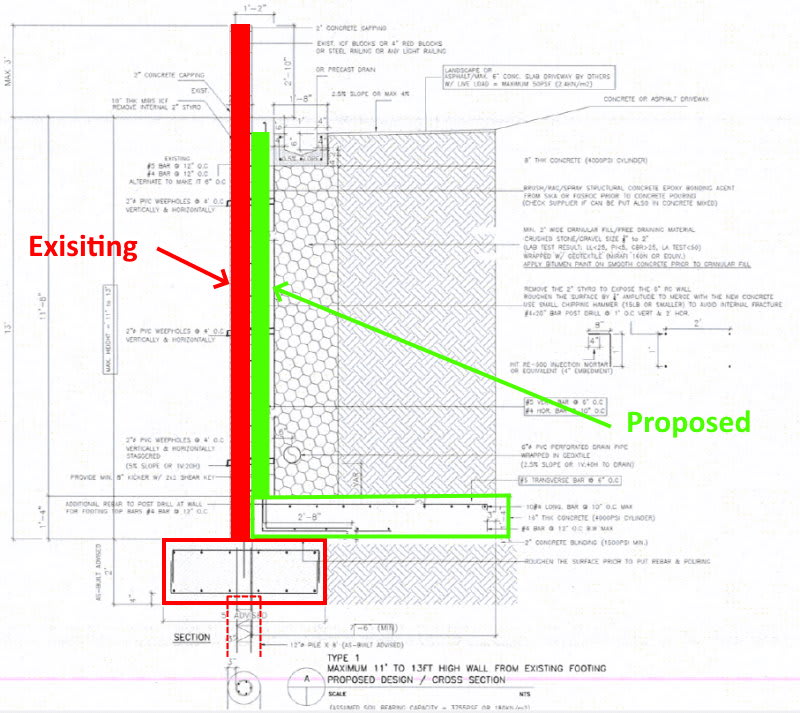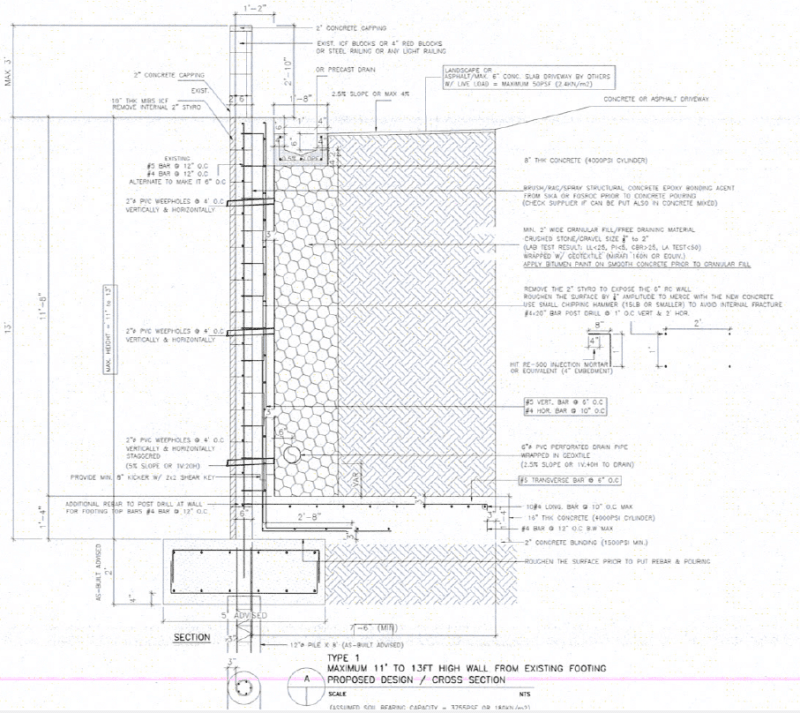Navigation
Install the app
How to install the app on iOS
Follow along with the video below to see how to install our site as a web app on your home screen.
Note: This feature may not be available in some browsers.
More options
Style variation
-
Congratulations MintJulep on being selected by the Eng-Tips community for having the most helpful posts in the forums last week. Way to Go!
You are using an out of date browser. It may not display this or other websites correctly.
You should upgrade or use an alternative browser.
You should upgrade or use an alternative browser.
Retaining Footing - New on top of Existing 1
- Thread starter amphora
- Start date
- Status
- Not open for further replies.
- Thread starter
- #5
-
1
- #6
There's some concerns here in my opinion:
1. Top bars in your footing are not developed.
2. Stem could need to be thicker for this wall height.
3. Check reinforcing design (same bar size and spacing in wall and footing yet the wall has a d=5" and footing has d=13")
4. Vertical bars are hooked towards heel, see thread here for additional info:
1. Top bars in your footing are not developed.
2. Stem could need to be thicker for this wall height.
3. Check reinforcing design (same bar size and spacing in wall and footing yet the wall has a d=5" and footing has d=13")
4. Vertical bars are hooked towards heel, see thread here for additional info:
SlideRuleEra
Structural
Amphora - No, this design is not ok. The geometry of the proposed wall is "terrible", but that's not why I'm posting. Normally, I would skip a post where the OP should be asking his boss for basic help. I'll make an exception for one reason... the design is a potential death trap (not an exaggeration) for workers constructing it.
Go see your boss.
Go see your boss.
- Thread starter
- #8
SlideRuleEra
Structural
amphora - I misunderstood your objective, sorry.
This is my understand of the design, exiting in red, proposed in green:

My comments on design:
1) For overturning of the retaining wall, note that the "pivot point" is on the existing pile cap. A large, slightly eccentric load applied to the pile cap. Perhaps more than the pile/cap were designed for.
2) For sliding of the retaining wall, horizontal friction applying lateral force to the pile cap. Perhaps more than the pile/cap were designed for.
3) Proposed retaining wall is partially supported by piling and partially on it's own heel slab. Never a good combination, risk of differential settlement and problems associated with it.
4) Proposed retaining wall does not have a "toe". Because of this geometry, difficult (but not impossible) to design a cantilever retaining wall that meets overturning and sliding requirements.
My comments on constructability:
1) Existing 11+ foot high wall has "failed", I assume this means structurally compromised in some manner. It's not a properly designed retaining wall, anyway. Just a "regular" wall, no surprise it has failed. Full depth excavation to construct the new wall may (and likely would) collapse the existing (failed) wall... possibly onto workers.
2) If the existing wall survives excavation and preparation of concrete placement, then the existing (failed) wall will be subjected to hydrostatic pressure from fresh concrete. Possibly collapsing the existing (failed) wall onto workers.
Suggestion: Demolish the existing (failed) wall and design/construct a replacement retaining wall (that has a toe). Far less risky and expensive.
Note: If my understanding of the drawing is wrong, of course, my comments may be wrong also.
This is my understand of the design, exiting in red, proposed in green:

My comments on design:
1) For overturning of the retaining wall, note that the "pivot point" is on the existing pile cap. A large, slightly eccentric load applied to the pile cap. Perhaps more than the pile/cap were designed for.
2) For sliding of the retaining wall, horizontal friction applying lateral force to the pile cap. Perhaps more than the pile/cap were designed for.
3) Proposed retaining wall is partially supported by piling and partially on it's own heel slab. Never a good combination, risk of differential settlement and problems associated with it.
4) Proposed retaining wall does not have a "toe". Because of this geometry, difficult (but not impossible) to design a cantilever retaining wall that meets overturning and sliding requirements.
My comments on constructability:
1) Existing 11+ foot high wall has "failed", I assume this means structurally compromised in some manner. It's not a properly designed retaining wall, anyway. Just a "regular" wall, no surprise it has failed. Full depth excavation to construct the new wall may (and likely would) collapse the existing (failed) wall... possibly onto workers.
2) If the existing wall survives excavation and preparation of concrete placement, then the existing (failed) wall will be subjected to hydrostatic pressure from fresh concrete. Possibly collapsing the existing (failed) wall onto workers.
Suggestion: Demolish the existing (failed) wall and design/construct a replacement retaining wall (that has a toe). Far less risky and expensive.
Note: If my understanding of the drawing is wrong, of course, my comments may be wrong also.
- Thread starter
- #10
SlideRuleEraYour - Your understanding of the drawing is correct. The wall failed due to overturning. I agree with your recommendation to demolish.
Also, I believe the drawing assumes the wall is perfectly vertical which would not be the case given the failure mode.
One thing though:
You stated a full depth excavation to construct the new wall may (and likely would) collapse the existing (failed) wall. Wouldn't the excavation of the backfill material help alleviate the pressure the existing wall is experiencing, preventing further overturning?
Also, I believe the drawing assumes the wall is perfectly vertical which would not be the case given the failure mode.
One thing though:
You stated a full depth excavation to construct the new wall may (and likely would) collapse the existing (failed) wall. Wouldn't the excavation of the backfill material help alleviate the pressure the existing wall is experiencing, preventing further overturning?
SlideRuleEra
Structural
amphora said:Wouldn't the excavation of the backfill material help alleviate the pressure the existing wall is experiencing, preventing further overturning?
The short answer is "Yes"... but, as always, there is more to it. The existing (failed) wall would have to survive the excavation process.
After a few years, the wall is more or less at equilibrium with retained soil. Overturning may be continuing, but likely in slow motion. The wall has length, 3-dimensional, but the excavation process (perhaps with a backhoe or crane using clamshell bucket) progresses one point (bucket-full) at a time along the length and height of the wall. This activity will subject to wall to changing, sudden equilibrium disruption. There is also the real possibility the equipment operator will accidentally "slam" the bucket into the wall. Surviving all of this a lot to ask of free-standing 6" thick, 12+ feet high (failed) wall. The wall should be temporarily braced before excavation begins.
Then comes preparation for proposed wall concrete placement. Unless the existing (failed) wall is drilled (to allow use of concrete form ties), a one-sided concrete form will have to used for the back side. Design of this type form is an engineering project by itself. Unless concrete is placed precisely, continuously, and slowly, fresh concrete hydrostatic pressure (150 PSF) will certainly collapse the (failed) wall. For reference, the (failed) wall is overturning from retained soil's equivalent liquid pressure of, say 25 to 35 PSF.
ACI 347R "Guide to Concrete Formwork" gives an idea of the variables for fresh concrete lateral pressure.
- Status
- Not open for further replies.
Similar threads
- Question
- Replies
- 6
- Views
- 12K
- Question
- Replies
- 12
- Views
- 12K
- Question
- Replies
- 7
- Views
- 1K
- Locked
- Question
- Replies
- 2
- Views
- 1K
- Locked
- Question
- Replies
- 8
- Views
- 4K

